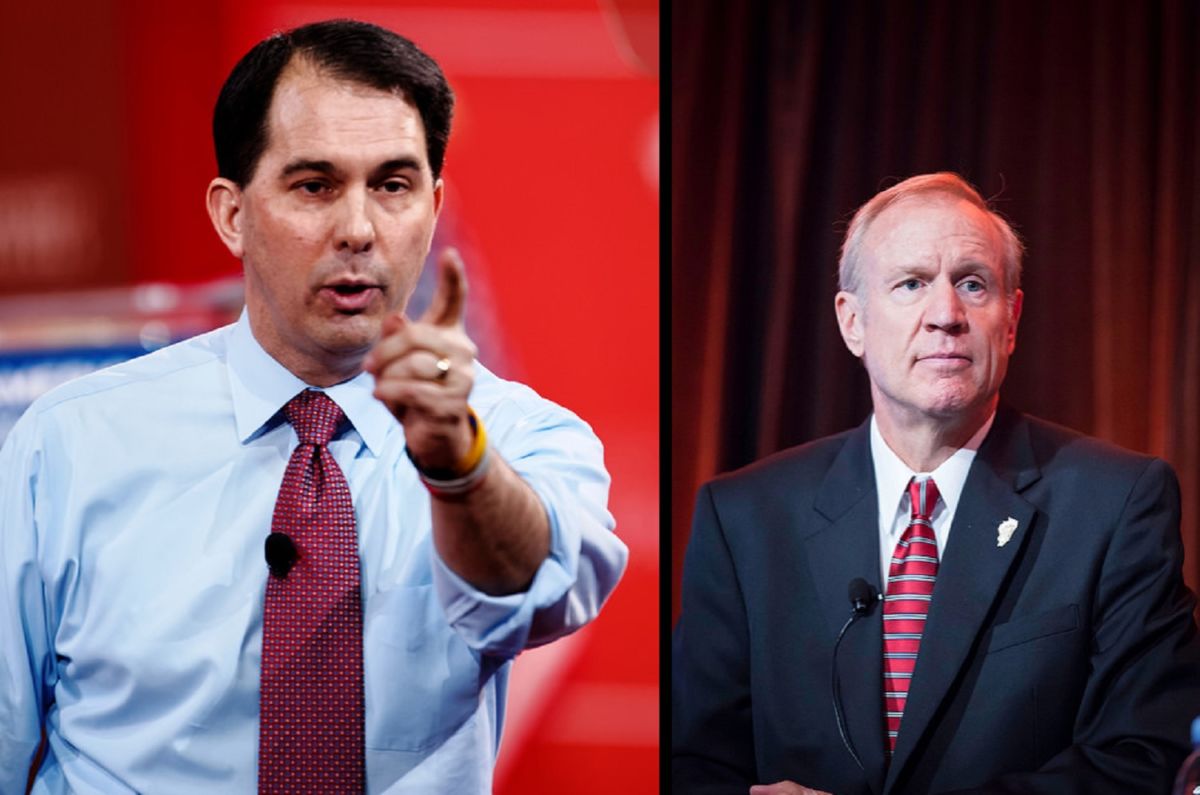On Tuesday night, in a strong rebuke to the anti-labor agendas of Wisconsin and Illinois’ Republican governors, voters elected Democrats to lead their states. Illinois’ new governor, Democrat J.B. Pritzker, won the race with 54 percent of the vote, while Wisconsin’s new governor, Tony Evers, won his contest, though final votes are still being tallied. Both ran on strong, clear messages of supporting unions and working families.
It would be hard to understate the damage to workers wrought by Scott Walker, elected during the Tea Party wave of 2010, and Bruce Rauner, elected in 2014. Walker wasted no time taking aim at organized labor: In 2011 he proposed the notorious Act 10, legislation which stripped public school teachers of their right to collectively bargain, on top of slashing their health insurance and pension benefits. Act 10 inspired 100,000 people to protest at the state capitol, but when Walker easily won a recall election in 2012, he grew emboldened. Republicans repealed Wisconsin’s prevailing wage laws for state and local government funded projects, and Wisconsin’s minimum wage remains stuck at $7.25. The last time it was raised was nearly a decade ago.
Prior to Act 10, the state’s largest teachers union—the Wisconsin Education Association Council (WEAC)—boasted 98,000 members. By 2016, that number had dropped to 36,074. As of August, WEAC membership had fallen even further, to just over 32,000 educators. Overall union membership across the state is down too: There were 355,000 union members across Wisconsin in 2010, but as of 2017, that number stood at 230,000.
In Illinois, Rauner’s record was similarly hostile to workers. Upon taking office in 2015, the governor’s first order of business was to introduce his so-called “Turnaround Agenda”—a wish-list of 44 proposals that he insisted were needed to save the state. Among them were calls to eliminate collective bargaining for public sector unions, establish right-to-work zones throughout the state, and end prevailing wage laws. He later would veto a bill that would have raised his state’s $8.25 minimum wage to $15 an hour by 2022, and issued an executive order that gave state workers permission to not pay union agency fees, a decree that led ultimately to the case which ended agency fees for good at the U.S. Supreme Court, Janus v. AFSMCE.
Meanwhile, the contrast presented by their opponents, Pritzker and Evers, was tremendous. Both Democrats support raising the minimum wage to $15 an hour, and spoke often about the important role unions play in building strong, inclusive economies. Pritzker described his intent to beef up enforcement for a 2010 wage theft law, and a state task force meant to tackle worker misclassification. Evers, who has served as Wisconsin’s state superintendent since 2009, spoke regularly about the ways Act 10 hurt educators, and public education more broadly. He also spoke out against changes made to the state’s prevailing wage laws, and Wisconsin’s prohibition on local communities raising their minimum wage or passing other pro-worker measures like paid sick leave.
Unions helped make Tuesday night’s victories a reality.
One powerful factor was the Red for Ed movement—the national teacher-led push to reclaim public schools. In Wisconsin, twenty percent of voters ranked education as their most important issue this election, and Christina Brey, a spokesperson for WEAC, said one new feature of the 2018 cycle was the influx of new grassroots public school advocacy groups mobilizing around the state. “It’s not just teachers, but parents and community members have been engaged in ways we haven’t seen before,” she said. “Whether you’re an educator, or a construction worker, or in public service or in the private sector, it’s just been crystal clear that Walker’s policies have hurt our families.”
In Illinois, one union took a particularly unconventional strategy to help defeat Rauner. In addition to the broad coalition of labor groups that rallied early and loudly behind Pritzker, the influential International Union of Operating Engineers Local 150 helped fund a pro-union conservative candidate, Sam McCann, who ran to Rauner’s right on a host of social issues. Local 150 represents workers in the landfill and public works industries, and nearly half of its members are registered Republicans.
“We felt we needed to provide our conservative members a labor friendly alternative to Rauner,” said Ed Maher, the spokesperson for Local 150. “Trump and Rauner didn’t become president without the help of union voters.” Maher acknowledged some other Illinois unions questioned their strategy of backing a far-right candidate, but he defended their approach. “It’s math, peeling off more votes from Rauner, and if we’re not willing to be as ruthless as our enemies, then labor’s hope for victory is dim,” he said.
In the end, Sam McCann won just over 4 percent, falling short of the 5 percent threshold needed to place the Conservative Party automatically on the Illinois 2020 ballot.
The night wasn’t a total win for labor-backed candidates in the Midwest. Randy Bryce, the union ironworker and labor activist, lost his Wisconsin contest to Republican Bryan Steil. And Richard Cordray lost his Democratic governor’s bid in Ohio.
Still, with Democratic governors elected in Michigan, Wisconsin, Pennsylvania and Minnesota—many working families in the region have brighter years to look forward to.
Join us in defending the truth before it’s too late
The future of independent journalism is uncertain, and the consequences of losing it are too grave to ignore. To ensure Truthout remains safe, strong, and free, we need to raise $34,000 in the next 72 hours. Every dollar raised goes directly toward the costs of producing news you can trust.
Please give what you can — because by supporting us with a tax-deductible donation, you’re not just preserving a source of news, you’re helping to safeguard what’s left of our democracy.
